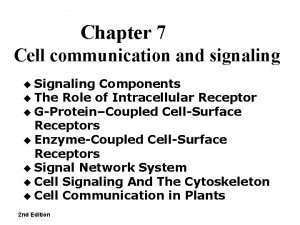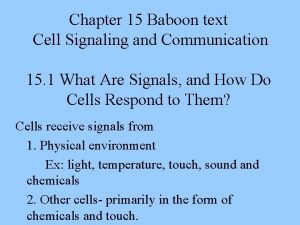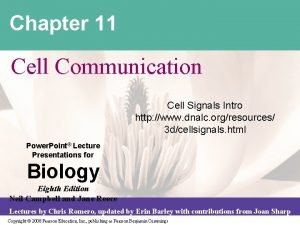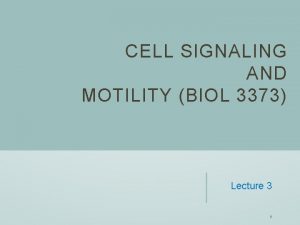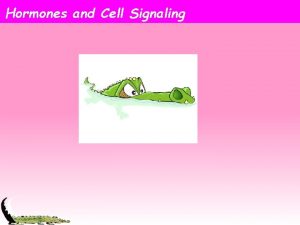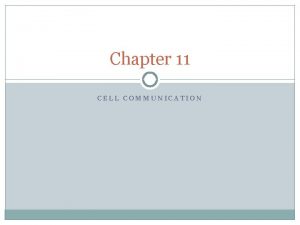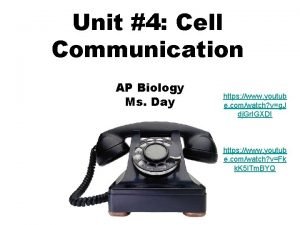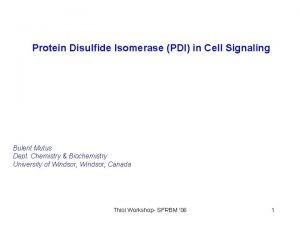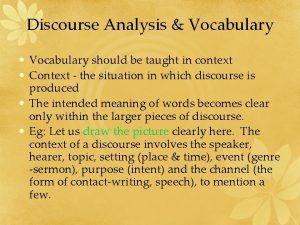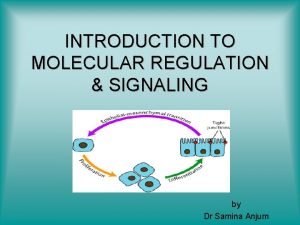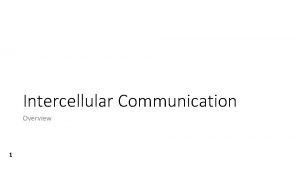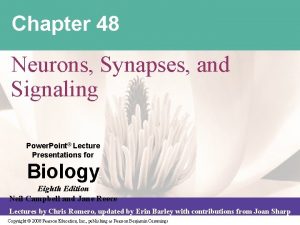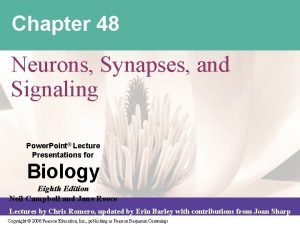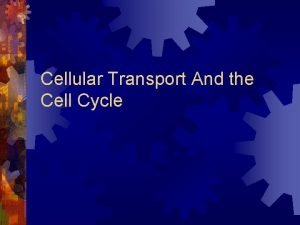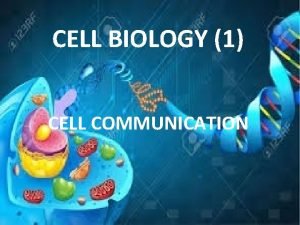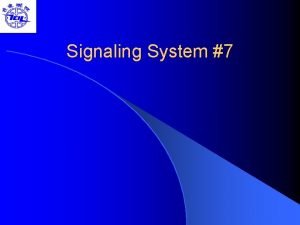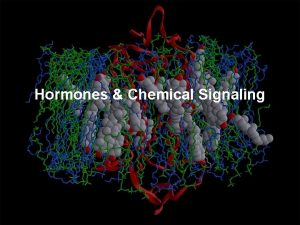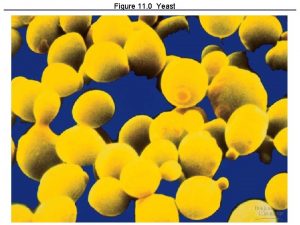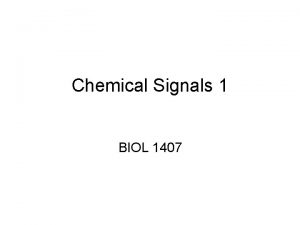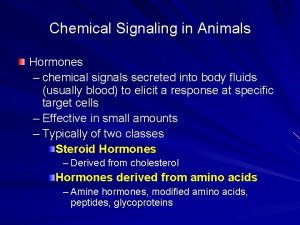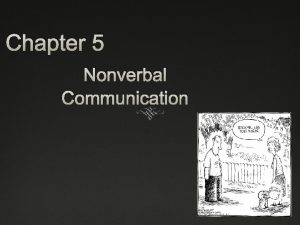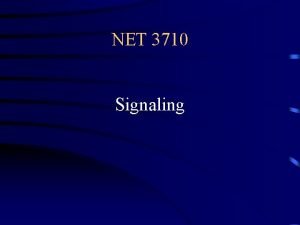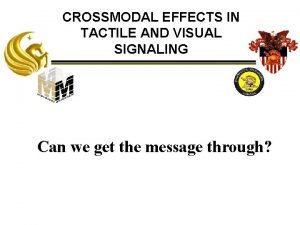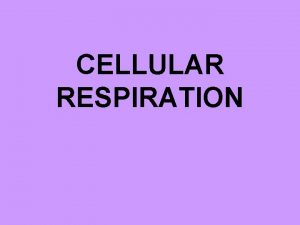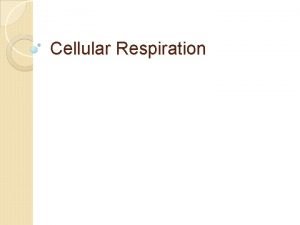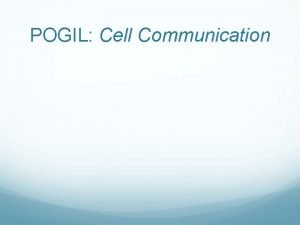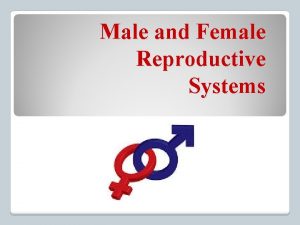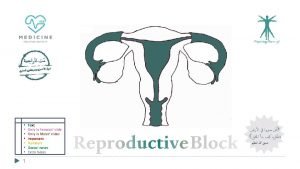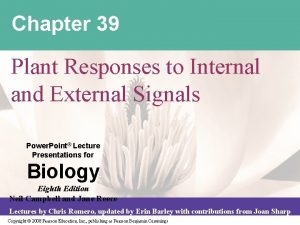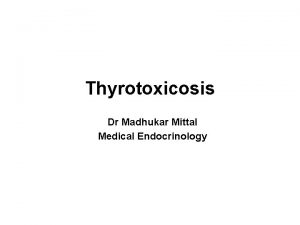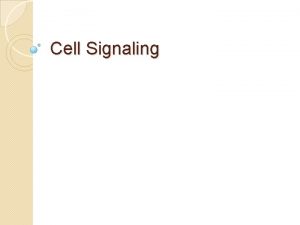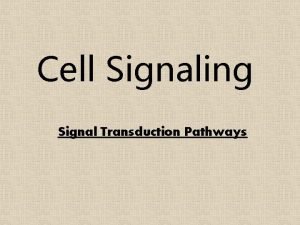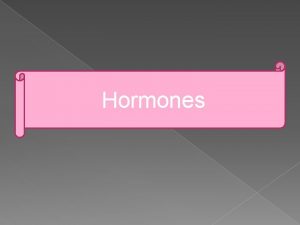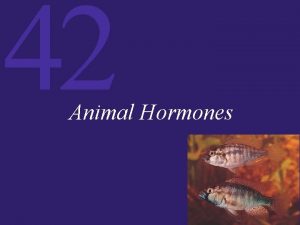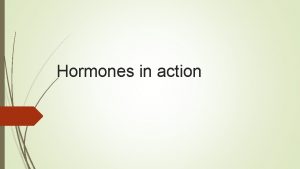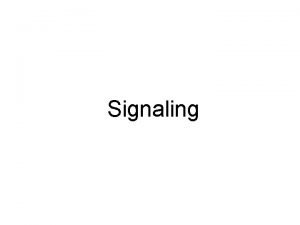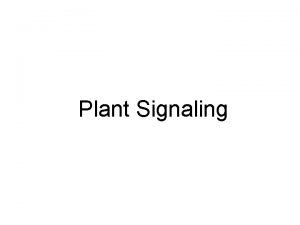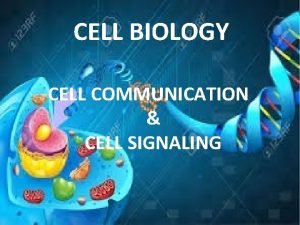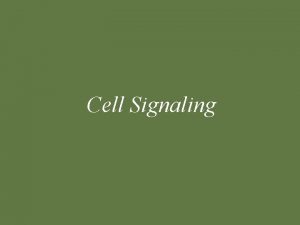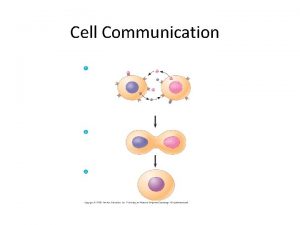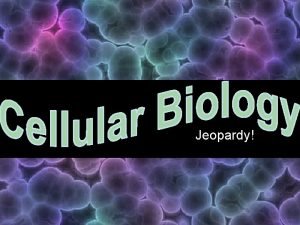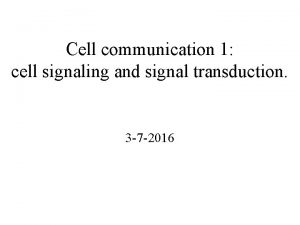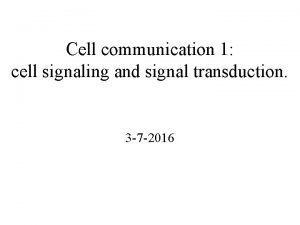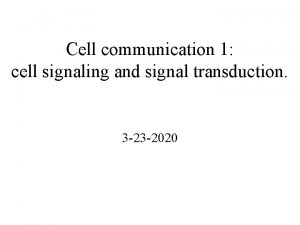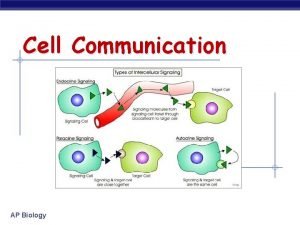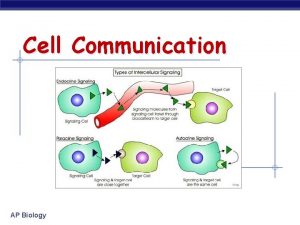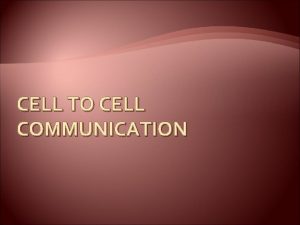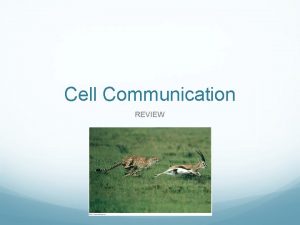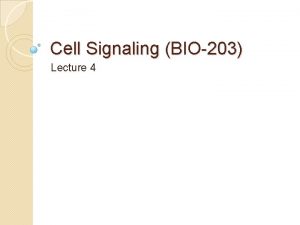Hormones and Cell Signaling Cellular Communication Everything an

















































- Slides: 49

Hormones and Cell Signaling

Cellular Communication • Everything an animal does involves communication among cells • e. g. , moving, digesting food • Cell signaling – communication between cells • Signaling cell: sends a signal (usually chemical) • Target cell: receives the signal

Types of Cell Signaling Direct: via gap junctions Indirect: signaling cell releases a chemical messenger that binds to a receptor on the target cell and activates a signal transduction pathway • Short distances • Paracrine: diffusion to a nearby cell • Autocrine: diffusion back to the signaling cell • Long distances • Endocrine: hormone is transported by the circulatory system • Neural: electrical signal travels along a neuron and releases a neurotransmitter

Types of Cell Signaling

Chemical Messengers Two main types 1. Hydrophilic 2. Hydrophobic

Direct Signaling • Gap junctions – specialized protein complexes that create an aqueous pore between two adjacent cells • Hydrophilic chemical messengers can travel through the lipid membrane • Typically involves the movement of ions

Indirect Signaling Three steps 1. Release of chemical messenger from the signaling cell 2. Transport of the messenger through the extracellular environment to the target cell 3. Communication of the signal to the target cell

Release of the Chemical Messenger • Hydrophobic messengers can cross the cell membrane by diffusion • Hydrophilic messengers are packed into vesicles where they are stored until they are released by exocytosis • Exocytosis – vesicle fuses with the plasma membrane and releases its contents

Transport to the Target Cell • Hydrophilic messengers dissolve in aqueous solutions like extracellular fluid and blood • Hydrophobic messengers bind to carrier proteins in the blood • Carrier protein – help hydrophobic messengers dissolve in aqueous solutions • M + C M-C

Transport of Hydrophobic Messengers

Communication to the Target Cell • Receptors • Hydrophilic: transmembrane protein • Hydrophobic: intracellular proteins • Ligand – chemical messenger that can bind to a specific receptor • The receptor changes shape when it binds to the receptor

Ligand-Receptor Interactions • Only the correctly shaped ligand (natural ligand) can bind to the receptor • Ligand mimics (e. g. , drugs and poisons) • Agonists – activate receptors • Antagonists – block receptors

Ligand-Receptor Dynamics • L + R L-R response • More free ligand (L) or receptors (R) will increase the response • Receptors can become saturated

Ligand-Receptor Dynamics, Cont. • More receptors response • Higher affinity constant (Ka) response • Down-regulation – constant exposure to ligands decrease the number of receptors, e. g. , habitual coffee drinkers (mmmmmhhh) • Up-regulation – opposite, e. g. , alcohol withdrawal

Signal Transduction Pathways Convert the change in shape of a receptorligand into a complex intracellular response

Transducers • Convert signals from one form to another • Four components • Receiver: ligand binding receptor • Transducer: conformational change of the receptor • Amplifier: the signal transduction pathway increases the number of molecules affected • Responder: something that responds to the signal

Types of Receptors

Intracellular Receptors Regulate the transcription of target genes by binding to specific DNA sequences, and increasing or decreasing m. RNA production

Ligand-Gated Ion Channels • • Ligand binds to receptor Receptor changes shape opening a channel Ions move across the membrane Concentration and electrical gradients dictate the direction of ion movement • Movement of ions change ion concentrations which alters the membrane potential

Receptor Enzymes • When activated by a ligand the catalytic domain starts a phosphorylation cascade • Named based on the reaction catalyzed

G-Protein-Coupled Receptors • Transmembrane protein that interacts with intracellular G -proteins • G-proteins – named for their ability to bind guanosine nucleotides • Activate second messengers

Second Messengers

Systems for Cell Signaling

Autocrine and Paracrine • Many chemicals act as paracrine messengers • Eicosanoids – act only in autocrine and paracrine cell signaling • Prostaglandins – involved in pain reception; blocked by many painkillers

Nervous System • Specialized collection of cells that can carry signals across long distances • Neurons allow electrical signals to be propagated across long distances within a single cell • Synapse – region in between two neurons or a neuron and other target cells • Gap junctions • Chemical: neurotransmitters

Endocrine System • Sends chemicals (hormones) through the blood • Produced by endocrine glands • Other chemicals can act as hormones, e. g. , neurohormones • Non-endocrine organs can produce hormones, e. g. , heart • Three types of hormones • Peptides • Steroids • Amines

Three Types of Hormones

Peptide Hormones • • Synthesized on the rough ER Stored in vesicles Leave signaling cell via exocytosis Soluble in aqueous solutions and travel to the target cell dissolved in the extracellular fluid • Hydrophilic: cannot cross the target cell membrane • Bind to transmembrane receptors • Rapid effects on the target cell

Synthesis of Peptide Hormones

Steroid Hormones • Derived from cholesterol • Hydrophobic: can pass through the plasma membrane • Enzymes for synthesis are in the smooth ER or mitochondria • Cannot be stored within the cell

Steroid Hormones, Cont. • Must be synthesized on demand • Transported to target cell by carrier proteins (e. g. , albumin) • Sloooooow effects on the target cell (regulate transcription) – exception: stress hormone cortisol has rapid non-genomic effects

Three Classes of Steroid Hormones • Mineralocorticoids • Electrolyte balance • e. g. , aldosterone • Glucocorticoids • Stress hormones • e. g. , cortisol • Reproductive hormones • Regulate sex-specific characteristics and reproduction • e. g. , estrogen, progesterone, testosterone

Amine Hormones • Chemicals that possess amine (-NH 2) • e. g. , acetylcholine, catecholamines (dopamine, norepinephrine, epinephrine), serotonin, melatonin, histamine, thyroid hormones • Some are true hormones, some are neurotransmitters, some are both • Diverse effects

Exocrine Cell Signaling • Secretions via ducts to the outside of the body including the skin, respiratory surfaces, and the gut • e. g. , salivary glands, prostate, sweat glands • Cell-to-cell: pheromones, allelochemicals

Regulation of Cell Signaling • Feedback • Positive – output acts as a further stimulus • Negative – output reduces the stimulus

Regulation of Cell Signaling, Cont.

Direct Endocrine Pathways • Simplest system • Endocrine organ acts as the receptor, the integrating center, and the endocrine organ • e. g. , parathyroid hormone

Second Order Endocrine Pathways • • • Epinephrine – “fight-or-flight” response Sense organ perceives and alarming stimulus Sensory nerves send signals to the brain Brain integrates the signals and sends signal out via the motor nerves Adrenal medulla responds to this signal by releasing epinephrine Epinephrine interacts with the heart and muscles

Simultaneous Response Pathways Insulin is part of a direct stimulus-response pathway and a second -order pathway

Pituitary Hormones • The pituitary gland secretes many hormones • Two distinct sections • Anterior pituitary • Posterior pituitary

Posterior Pituitary • Extension of the hypothalamus • Neurons that originate in the hypothalamus terminate in the posterior pituitary • Cell bodies synthesize neurohormones that travel in vesicles down the axons • e. g. , Oxytocin and vasopressin • First-order endocrine pathway

Anterior Pituitary Hypothalamus synthesizes and secretes neurohormones Portal system Anterior pituitary • Tropic hormones – cause the release of another hormone • Third-order endocrine pathway

Regulation of Blood Glucose • Very tightly controlled • Too low brain cannot function • Too high osmotic balance of the blood is disturbed • Hormones: insulin and glucagon • Antagonistic pairing – hormones have opposite effects

Evolution of Cell Signaling • Mechanisms for cell signaling share many similarities in all animal groups • Must have originated in a common ancestor

Unicellular Organisms • Can sense and respond to their environment • Use mechanisms similar to cell signaling in animals • Examples • Motile bacteria: sense and move towards chemoattractants using transmembrane receptor proteins • Yeast: secrete mating factor pheromones that bind only to receptors on cells of the opposite mating type • Slime molds: free-living amoeboid organisms that form multicellular colonies; secrete c. AMP to attract other cells that have specific receptors for c. AMP

Plants vs. Animals • Pathways have similar outlines, but different details • Similarities • Use Ca 2+ as a secondary messenger • Have many pathways that involve protein kinases • Differences • Plants do not have receptor tyrosine kinases or Ras proteins • Plants have unique transmembrane serine/threonine kinases

Vertebrates vs. Invertebrates • • • All have nervous systems; except sponges Circulatory systems arose independently in several groups, e. g. , arthropods and vertebrates Endocrine systems could only arise in groups with circulatory systems and therefore also arose independently • All vertebrates use a series of steroid hormones, e. g. , estrogens, and corticosteroids • Only estrogen has been found in invertebrates • Insects and crustaceans use a different series of steroids (e. g. , ecdysone) to regulate molting and metamorphosis

Vertebrate Hormones • Alterations in the way tissues respond to a hormone, rather than a change in the hormones • Similarities • Many hormones are affective across many groups, e. g. , human growth hormone increase growth rate in fish, estrogen from pregnant mares are used in menopausal women • Differences • Prolactin stimulates milk production in mammals, inhibits metamorphosis and promotes growth in amphibians, and regulates water balance in fish

Vertebrate Endocrine Organ Structure • Adrenal glands • The location of interrenal and chromaffin tissue differ across groups
 3 types of cell signaling
3 types of cell signaling Chemical signalling
Chemical signalling Chapter 11 cell communication
Chapter 11 cell communication Three stages of cell signaling
Three stages of cell signaling Exocrine cell signaling
Exocrine cell signaling Cell signaling
Cell signaling Cell signaling overview
Cell signaling overview Pdi cell signaling
Pdi cell signaling Reiteration in discourse analysis
Reiteration in discourse analysis Register and signaling vocabulary
Register and signaling vocabulary Autocrine and juxtacrine signaling
Autocrine and juxtacrine signaling Autocrine and juxtacrine signaling
Autocrine and juxtacrine signaling Chapter 48 neurons synapses and signaling
Chapter 48 neurons synapses and signaling Chapter 48 neurons synapses and signaling
Chapter 48 neurons synapses and signaling Cellular transport and the cell cycle
Cellular transport and the cell cycle Explanatory phrase examples
Explanatory phrase examples Vehicle ground guide hand signals
Vehicle ground guide hand signals Ligand signaling molecule
Ligand signaling molecule Signaling system 7
Signaling system 7 Chemical signaling
Chemical signaling Phosphorylation cascade
Phosphorylation cascade Chemical signaling
Chemical signaling Chemical signaling
Chemical signaling An embryonic industry is one that:
An embryonic industry is one that: Functional professional touch
Functional professional touch Scp 3710
Scp 3710 Use visual signaling techniques
Use visual signaling techniques All cells must contain
All cells must contain Where in the cell does cellular respiration occur
Where in the cell does cellular respiration occur Where in the cell does cellular respiration occur
Where in the cell does cellular respiration occur Cell communication pogil
Cell communication pogil Bioflix activity homeostasis hormones and homeostasis
Bioflix activity homeostasis hormones and homeostasis Chapter 45 hormones and the endocrine system
Chapter 45 hormones and the endocrine system Male and female hormones
Male and female hormones Male and female hormones
Male and female hormones Bioflix activity homeostasis hormones and homeostasis
Bioflix activity homeostasis hormones and homeostasis Respond to
Respond to Plant hormones and responses
Plant hormones and responses Synthesis and secretion of thyroid hormones
Synthesis and secretion of thyroid hormones Surfaces of thyroid gland
Surfaces of thyroid gland Cryoablation fibroadenoma
Cryoablation fibroadenoma Hormones
Hormones Difference between mercury cell and diaphragm cell
Difference between mercury cell and diaphragm cell Prokaryotic
Prokaryotic Venn diagram of plant and animal cell
Venn diagram of plant and animal cell Vacuole function
Vacuole function Animal vs plant cell
Animal vs plant cell Types of secondary cells
Types of secondary cells Difference between plant cell and bacterial cell
Difference between plant cell and bacterial cell Events of the cell cycle
Events of the cell cycle
